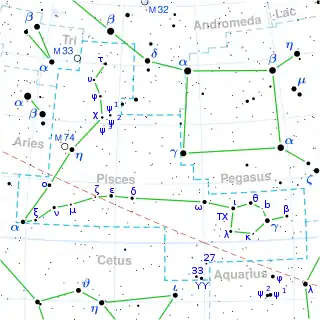 The narrow triangle in which this comparative star, in apparent magnitude (brightness viewed from Earth), figures. Click to show context | |
| Observation data Epoch J2000 Equinox J2000 | |
|---|---|
| Constellation | Pisces |
| Right ascension | 00h 05m 20.14193s[1] |
| Declination | −05° 42′ 27.4279″[1] |
| Apparent magnitude (V) | 4.61[2] |
| Characteristics | |
| Spectral type | K0 IIIb[3] |
| Apparent magnitude (U) | 6.52[2] |
| Apparent magnitude (B) | 5.65[2] |
| Apparent magnitude (R) | 3.83[2] |
| Apparent magnitude (I) | 3.29[2] |
| Apparent magnitude (J) | 2.89[2] |
| Apparent magnitude (H) | 2.31[2] |
| Apparent magnitude (K) | 2.21[2] |
| B−V color index | 1.029±0.037 |
| Variable type | RS CVn[3] |
| Astrometry | |
| Radial velocity (Rv) | −6.56±0.23[4] km/s |
| Proper motion (μ) | RA: −6.54[1] mas/yr Dec.: 87.85[1] mas/yr |
| Parallax (π) | 25.32 ± 0.53 mas[1] |
| Distance | 129 ± 3 ly (39.5 ± 0.8 pc) |
| Absolute magnitude (MV) | 1.63[5] |
| Orbit[6] | |
| Period (P) | 72.93 d |
| Eccentricity (e) | 0.272±0.017 |
| Periastron epoch (T) | 2,422,530.330±0.809 JD |
| Argument of periastron (ω) (secondary) | 337.71±4.60° |
| Semi-amplitude (K1) (primary) | 16.43±0.31 km/s |
| Details[7] | |
| Mass | 0.83±0.22 M☉ |
| Radius | 7[8] R☉ |
| Luminosity | 24[8] L☉ |
| Surface gravity (log g) | 2.620±0.11 cgs |
| Temperature | 4,736±92 K |
| Metallicity [Fe/H] | −0.12±0.05 dex |
| Rotational velocity (v sin i) | 0.0[8] km/s |
| Age | 4.8+3.3 −1.2 Myr |
| Other designations | |
| Database references | |
| SIMBAD | data |
33 Piscium is a binary star system in the zodiac constellation of Pisces. It is visible to the naked eye with an apparent visual magnitude of 4.61.[2] The distance to this system, as determined from an annual parallax shift of 25.32±0.53 mas,[1] is about 129 light years. It is moving closer to the Sun with a heliocentric radial velocity of −6.6 km/s.[4]
This system was found to have a variable radial velocity by Leah Allen and Adelaide Hobe of Lick Observatory in 1911.[10] It was identified as a single-lined spectroscopic binary, and the orbital elements were published by Canadian astronomer W. E. Harper in 1926.[3] The pair have an orbital period of 72.93 days and an eccentricity of 0.27.[6] This is a RS Canum Venaticorum variable,[3] indicating a close binary system with active star spots, and has the variable star designation BC Psc.[11]
The primary, component A, is a first-ascent red giant with a stellar classification of K0 IIIb, having chemical abundances that match a first dredge-up mixing model. Pourbaix & Boffin (2003) estimated the mass of the primary as 1.7±0.4 M☉ and the secondary as 0.76±0.11 M☉.[3] However, Feuillet et al. (2016) derived a much lower mass estimate of 0.83±0.22 M☉ for the primary.[7] At the age of roughly five[7] billion years, the star has expanded to 7 times the radius of the Sun.[8] It is radiating 24[8] times the Sun's luminosity from its photosphere at an effective temperature of about 4,736 K.[7]
References
- 1 2 3 4 5 6 van Leeuwen, F. (2007), "Validation of the new Hipparcos reduction", Astronomy and Astrophysics, 474 (2): 653–664, arXiv:0708.1752, Bibcode:2007A&A...474..653V, doi:10.1051/0004-6361:20078357, S2CID 18759600.
- 1 2 3 4 5 6 7 8 9 Ducati, J. R. (2002), "VizieR Online Data Catalog: Catalogue of Stellar Photometry in Johnson's 11-color system", VizieR On-line Data Catalog, 2237, Bibcode:2002yCat.2237....0D.
- 1 2 3 4 5 Barisevičius, G.; et al. (2011), "Chemical Composition of the RS CVn-type Star 33 Piscium", Baltic Astronomy, 20: 53–63, arXiv:1105.5650, Bibcode:2011BaltA..20...53B, doi:10.1515/astro-2017-0268, S2CID 118081703.
- 1 2 de Bruijne, J. H. J.; Eilers, A.-C. (October 2012), "Radial velocities for the HIPPARCOS-Gaia Hundred-Thousand-Proper-Motion project", Astronomy & Astrophysics, 546: 14, arXiv:1208.3048, Bibcode:2012A&A...546A..61D, doi:10.1051/0004-6361/201219219, S2CID 59451347, A61.
- ↑ Anderson, E.; Francis, Ch. (2012), "XHIP: An extended hipparcos compilation", Astronomy Letters, 38 (5): 331, arXiv:1108.4971, Bibcode:2012AstL...38..331A, doi:10.1134/S1063773712050015, S2CID 119257644.
- 1 2 Harper, W. E. (October 1926), "Two K-type spectroscopic binaries", Publications of the Dominion Observatory Ottawa, 3: 341–348, Bibcode:1926PDAO....3..341H.
- 1 2 3 4 Feuillet, Diane K.; et al. (2016), "Determining Ages of APOGEE Giants with Known Distances", The Astrophysical Journal, 817 (1): 15, arXiv:1511.04088, Bibcode:2016ApJ...817...40F, doi:10.3847/0004-637X/817/1/40, S2CID 118675933, 40.
- 1 2 3 4 5 Massarotti, Alessandro; et al. (January 2008), "Rotational and Radial Velocities for a Sample of 761 HIPPARCOS Giants and the Role of Binarity", The Astronomical Journal, 135 (1): 209–231, Bibcode:2008AJ....135..209M, doi:10.1088/0004-6256/135/1/209, S2CID 121883397.
- ↑ "33 Psc". SIMBAD. Centre de données astronomiques de Strasbourg. Retrieved 2018-03-12.
- ↑ Campbell, William Wallace; et al. (1911), "Sixty-eight stars whose radial velocities vary", Lick Observatory Bulletin, 199: 140–154, Bibcode:1911LicOB...6..140C, doi:10.5479/ADS/bib/1911LicOB.6.140C.
- ↑ Kazarovets, E. V.; Samus, N. N. (October 1990), "The 70th Name-List of Variable Stars", Information Bulletin on Variable Stars, 3530: 1, Bibcode:1990IBVS.3530....1K.